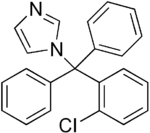Clotrimazole
Definition of clotrimazole:
Clotrimazole is a pharmaceutical. Its main use is for treatment of dermatological and gynaecological fungal infections.[1]
This is the common definition for clotrimazole, other definitions can be discussed in the article
|
Notes
| Clotrimazole |
|---|

|
| Formula |
| C22H17ClN2 |
Approximately 10 tonnes are produced in the EU each year, and almost the same quantity is imported. The main potential source of clotrimazole to the environment is discharges from municipal waste water treatment plants as a result of waste water from households.[1]
Clotrimazole has a low water solubility, the maximum concentration which in water is only 0,49 mg/l. It is considered a persistent substance which shows little or no biodegradability. It has only a low to moderate tendency to bioacumulate. It is a toxic substance for aquatic organisms. Concentrations of only 0,02 mg/l have lethal effects on crustaceans. Fish can tolerate concentrations up to 0,29 mg/l. However prolonged exposure to concentrations of 0,025 mg/l might already cause effects on the fish.
The highest concentrations measured in estuaries is 22 ng/l, the median measured concentrations in estuaries is 7ng/l.
At present OSPAR considers it unnecessary to propose measures for the reduction of discharges of clotrimazole.[1]
Clotrimazole belongs to the group of 14a-demethylase inhibiting fungicides. It is widely used in human and veterinary medicine and has been identified as a priority pollutant for the marine environment. However, the toxicity of clotrimazole to marine primary producers is largely unknown. We therefore sampled natural microalgal communities (periphyton) and exposed them to concentration series of clotrimazole over 4 days. 50 pmol/L clotrimazole caused a concentration-dependent accumulation of C14α-methylated sterol precursors, which coincided with a decrease in algal-specific C14-desmethyl sterols. This indicates an inhibition of algal 14a-demethylases already at environmental concentrations. A clotrimazole concentration of 500 pmol/L reduced total sterol content to 64% of control level. Community chlorophyll a content was affected by clotrimazole in a bi-phasic manner with first reductions becoming visible at 500 pmol/L, along with indications of an altered cycling of photoprotective xanthophyll pigments. Concentrations of 10-100 nmol/L and higher caused large reductions in community growth, and changed community pigment profiles in a concentration-dependent monotonous manner. The study further indicated that diatoms use obtusifoliol as a natural substrate for 14α-demethylase, just as higher plants do but also utilize norlanosterol.
MW= 344,8
Environmental standards and legislation
Included in the OSPAR list of substances of priority action
See also
OSPAR background document on clotrimazole